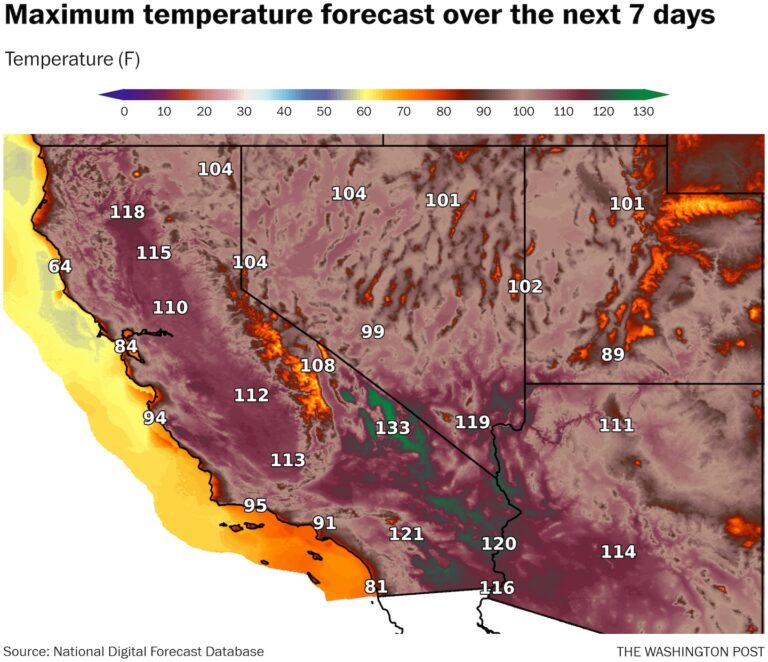Temperatures exceeding 100-120 degrees are becoming a daily occurrence in most parts of the state, with nighttime lows that are not much warmer and offer little relief. A powerful and unusually persistent heat dome is dissipating clouds and keeping cool fog at bay. This heat increases the threat of fires. Already the Thompson Fire in Northern California has grown to more than 3,000 acres and destroyed structures.
This dangerous heat has been predicted for as far into the future as reliable forecasts are available, threatening record highs of nearly 120 degrees as far north as Redding, and potentially approaching 130 degrees in Death Valley, the highest temperature ever reliably measured on Earth.
The Japan Meteorological Agency warned of the possibility of “multiple deaths from heatstroke and planned power outages.”
The heatwave comes amid the hottest year the planet has ever recorded. The past 13 months, including June, have been the hottest on record. Human-caused climate change has made a heatwave like this one in California at least five times more likely this week, according to science communications company Climate Central.
The map below helps show the severity of the heatwave to come.
Extreme heat warning covers 70% of state
More than 70 percent of California is under extreme heat warnings, with some of the weather service’s warnings extending out to seven days, an unprecedented length of time, according to the San Francisco Chronicle.
Cities under extreme heat warnings include Redding, Sacramento, Fresno, Bakersfield, Santa Barbara, Burbank and Palm Springs.
Less extreme heat watches are in effect for coastal cities including Los Angeles, Santa Maria and San Francisco, as well as parts of the Sierra Nevada mountain range. A few coastal areas are not under warning.
Temperatures could exceed 130 degrees.
The numbers are staggering. Most of California will see highs over 110 degrees Fahrenheit over the next week. Some areas will even exceed 120 degrees. Only the coastal areas and mountain tops will escape the 30s.
Death Valley, which holds the record for the hottest temperature ever observed on Earth, is expected to record highs of 126, 128, 130, 131, 131 and 133 degrees over the next six days. Death Valley’s world record high temperature was 134 degrees, recorded in 1913, but the reliability of that measurement is questionable. In 2020 and 2021, it reached 130 degrees, the highest temperature reliably observed in the modern record. Last summer, it recorded 129 degrees.
Heat dome is now stronger than ever
The heat dome causing these extreme temperatures is expected to reach record strength and hover over California and the southwestern US for seven to 10 days.
“This is the hottest synoptic pattern we have seen,” wrote the National Weather Service in Las Vegas, which could see record temperatures.
The heat will not just be confined to California, but will also affect much of the Southwest and at times the Pacific Northwest.
Studies have found that these heat domes are becoming larger and more intense due to human-induced climate change.
The Met Office is predicting a surge in record high temperatures and warmest minimum temperatures – perhaps hundreds of records will be broken by the time the heatwave is over.
Calendar records are most common, but monthly and all-time records may also be threatened. The number of records will increase through Thursday, with the highest numbers occurring Friday through early next week.
Among the all-time highs at stake are 121 cases in Palm Springs on Saturday, 118 cases in Redding on Saturday and 118 cases in Las Vegas on Monday.
The heatwaves could last for seven days.
On the federal heat risk index, which ranges from 0 to 4, temperatures are expected to reach levels 3 and 4, considered severe and extreme, every day for at least the next week in the Central Valley and desert areas.
At these levels, the risk of heat illness increases significantly, especially among vulnerable groups such as outdoor workers, the homeless and the elderly.
Major coastal cities will be largely spared, but areas inland will experience dangerously hot weather for several days.
Jason Samenow contributed to this report.

